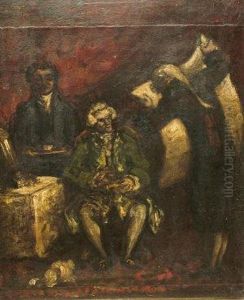H. Boughton Paintings
Henry Boughton, better known as H. Boughton, was a British-born American artist and illustrator known for his historical and genre paintings. Born on December 4, 1833, in Norwich, United Kingdom, Boughton showed an early interest in art. He emigrated to the United States with his family when he was just three years old, and they settled in Albany, New York.
Boughton's artistic training began under the tutelage of William Morris Hunt in Boston, and he later continued his education in France, studying at the École des Beaux-Arts in Paris. He was influenced by the French Barbizon school and the works of Jean-François Millet. Boughton's style often reflected a narrative quality, and he was particularly adept at illustrating scenes from history and literature, which made him a popular figure in both America and Britain.
Throughout his career, Boughton regularly exhibited his work. He was a member of various artistic institutions including the National Academy of Design in New York, where he was elected an Associate member in 1861 and a full Academician in 1863. His paintings were also shown at the Royal Academy in London, and he maintained strong connections with the British art world. In 1893, he was honored with the title of Chevalier of the Legion of Honor by the French government for his contributions to art.
Boughton's work often depicted scenes from American and British history with an emphasis on the Puritan era. One of his most famous paintings, 'The Return of the Mayflower', highlights his interest in Pilgrim history and showcases his narrative style. His focus on historical accuracy and detail was appreciated by his contemporaries and added educational value to his paintings. Boughton also illustrated works for authors such as Washington Irving and Henry Wadsworth Longfellow, further cementing his reputation as a skilled storyteller through his art.
Boughton's work is characterized by its attention to detail, historical accuracy, and the portrayal of quiet, often somber, scenes with a strong sense of mood and atmosphere. He was skilled in both oil and watercolor and produced a significant body of work that included illustrations, portraits, landscapes, and genre scenes.
Henry Boughton passed away on January 19, 1905, in London. His legacy includes not only his contributions to painting and illustration but also his influence on American and British art of the late 19th century. His works are held in various public collections, including the Metropolitan Museum of Art in New York and the Tate Gallery in London.
